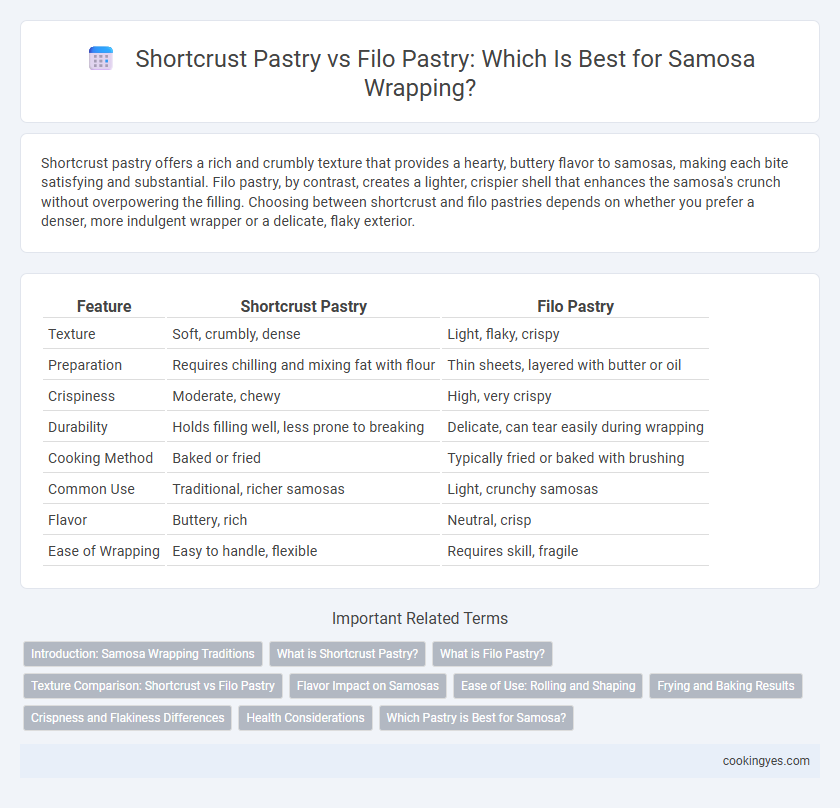Shortcrust pastry offers a rich and crumbly texture that provides a hearty, buttery flavor to samosas, making each bite satisfying and substantial. Filo pastry, by contrast, creates a lighter, crispier shell that enhances the samosa's crunch without overpowering the filling. Choosing between shortcrust and filo pastries depends on whether you prefer a denser, more indulgent wrapper or a delicate, flaky exterior.
Table of Comparison
| Feature | Shortcrust Pastry | Filo Pastry |
|---|---|---|
| Texture | Soft, crumbly, dense | Light, flaky, crispy |
| Preparation | Requires chilling and mixing fat with flour | Thin sheets, layered with butter or oil |
| Crispiness | Moderate, chewy | High, very crispy |
| Durability | Holds filling well, less prone to breaking | Delicate, can tear easily during wrapping |
| Cooking Method | Baked or fried | Typically fried or baked with brushing |
| Common Use | Traditional, richer samosas | Light, crunchy samosas |
| Flavor | Buttery, rich | Neutral, crisp |
| Ease of Wrapping | Easy to handle, flexible | Requires skill, fragile |
Introduction: Samosa Wrapping Traditions
Samosa wrapping traditions vary widely, with shortcrust pastry offering a sturdy, crumbly texture that holds rich fillings without sogginess, while filo pastry provides a light, flaky, and crisp exterior prized in many regional variations. Shortcrust pastry, made with flour, fat, and water, creates a dense shell ideal for soaking up flavorful sauces, whereas filo pastry, composed of ultra-thin layers brushed with butter or oil, delivers an airy crunch that enhances the overall eating experience. The choice between shortcrust and filo significantly influences the samosa's texture, durability, and culinary appeal across different cultural interpretations.
What is Shortcrust Pastry?
Shortcrust pastry is a type of dough made from flour, fat (usually butter), and water, known for its crumbly and tender texture, which provides a sturdy yet melt-in-the-mouth shell for samosas. Unlike filo pastry, shortcrust pastry offers a thicker, denser wrap that holds fillings securely and prevents sogginess due to its rich fat content. This makes shortcrust pastry ideal for samosas that require a robust casing to contain moist or heavy fillings without losing crispness.
What is Filo Pastry?
Filo pastry is a paper-thin, unleavened dough made from flour, water, and a small amount of oil or vinegar, traditionally used in Middle Eastern and Mediterranean cuisine. It creates a light, crispy texture when baked or fried, making it an excellent alternative to shortcrust pastry for samosa wrapping. Unlike shortcrust pastry, filo is layered and brushed with butter or oil, resulting in a delicate, flaky exterior that contrasts with the typically denser fillings of samosas.
Texture Comparison: Shortcrust vs Filo Pastry
Shortcrust pastry offers a dense, crumbly texture that creates a hearty, buttery exterior for samosas, enhancing their richness and providing a satisfying bite. In contrast, filo pastry delivers a thin, flaky, and crispy texture that results in a lighter, more delicate samosa with crisp layers that shatter upon eating. The choice between shortcrust and filo pastry influences the final samosa experience, with shortcrust emphasizing sturdiness and richness, while filo prioritizes crispiness and lightness.
Flavor Impact on Samosas
Shortcrust pastry creates a rich, buttery flavor that complements savory samosa fillings with a tender, crumbly texture, enhancing the overall taste experience. Filo pastry, with its thin, flaky layers, provides a lighter, crispier shell that emphasizes the filling's spices without overpowering them. The choice between shortcrust and filo significantly influences the samosa's flavor profile, affecting sweetness balance and mouthfeel.
Ease of Use: Rolling and Shaping
Shortcrust pastry offers a sturdier and more pliable texture, making it easier to roll and shape into traditional samosa triangles without tearing. Filo pastry, being thin and delicate, requires careful handling and multiple layers to prevent breakage during rolling and folding. For beginners, shortcrust pastry is generally more manageable, providing consistent results with less risk of pastry damage.
Frying and Baking Results
Shortcrust pastry produces a rich, crumbly texture with a golden-brown exterior when fried, offering a denser and buttery bite for samosas, while filo pastry yields a lighter, flakier, and crispier result due to its multiple thin layers, especially ideal for baking. Frying shortcrust samosas results in an even cooking with a slightly thicker crust that holds filling well without sogginess. Baked samosas with filo pastry develop an airy crunch and delicate crispness, making them a healthier alternative with reduced oil absorption.
Crispness and Flakiness Differences
Shortcrust pastry offers a denser, crumbly texture providing a rich, buttery flavor with moderate crispness in samosa wrapping. Filo pastry delivers a lighter, ultra-crispy, and flaky texture due to its multiple thin layers, creating an airy and crunchy bite. The choice between shortcrust and filo significantly affects the samosa's overall mouthfeel, with filo preferred for maximum crispness and shortcrust for a sturdier, melt-in-the-mouth experience.
Health Considerations
Shortcrust pastry for samosas typically contains higher fat content due to butter or shortening, resulting in a richer but more calorie-dense option. Filo pastry, made from thin layers of dough brushed with minimal oil or butter, offers a lighter alternative with lower saturated fat and fewer calories. Choosing filo pastry can reduce the overall fat intake while maintaining a crispy texture, making it a healthier choice for samosa wrapping.
Which Pastry is Best for Samosa?
Shortcrust pastry offers a richer, buttery flavor and a crumbly texture that complements the savory filling of samosas, making it a popular choice for those seeking a hearty bite. Filo pastry provides a lighter, crispier shell with multiple delicate layers, ideal for a flaky and less oily samosa experience. The best pastry depends on personal preference: shortcrust for robust taste and firmness, filo for a crunchy, lighter snack.
Shortcrust pastry vs Filo pastry for Samosa wrapping Infographic

 cookingyes.com
cookingyes.com